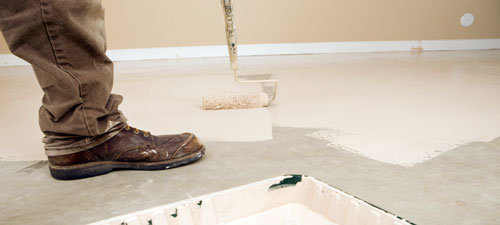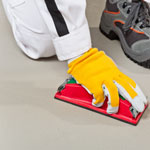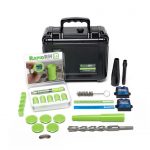Concrete Epoxy Coatings
Why Use Epoxy Coatings?
Epoxy coatings can supply a sleek, resilient finish to concrete floors. Many building owners choose epoxy for the following reasons:
1. Improve chemical resistance: An epoxy can help make a concrete slab more chemically-resilient to external elements.
2. Create a non-skid surface: In this way, the concrete epoxy acts as a simple surface treatment, removing the slide from the floor.
3. Aesthetics: More and more, concrete flooring is treated as a design feature. Just keep in mind that stamping, staining or specialized covering (such as terrazzo) requires stable concrete subfloor moisture content in order to work properly. Countless aesthetic flooring projects have been ruined by undue haste.

Surface Preparation
The first and best epoxy preparation is to allow concrete slabs sufficient time to fully dry in the first place. Industry rule-of-thumb: 30 drying days for each inch of slab thickness. Excess moisture content, however, is utterly oblivious to budgets, building schedules and move-in dates. It is also the surest way to risk floor finish failure. This is why Wagner Meters thoroughly researched and developed the Rapid RH® relative humidity test method: To ensure that slab moisture content confirms concrete subfloor readiness (or not).
The Wagner Meters Rapid RH® concrete moisture test is a surefire way to ensure that slab moisture content is stable enough for epoxy coatings. The Wagner Meters Rapid RH® is a methodically-proven slab moisture assessment upon which successful epoxy coating rests.
Concrete surfaces must also be clean in order for epoxies to adhere properly. A contaminated slab can seriously jeopardize the epoxy finish. A concrete slab surface needs the same due care and attention, if not more so, as any fine finished project if you want an epoxy coating to perform to specifications. Some common potential contaminants to look for might be:
- Oil, grease or wax: Using organic solvents, such as acetone and lacquer thinner, has long been considered the best approach to remove more water-resistant contaminants like wax, grease or oil from concrete surfaces. However, if applied with a rag, these solvents can actually deposit contaminants on the surface as they interact with the rag itself. Depending on the composition of the rag fiber, or even the detergents used to clean it, the solvent may release contaminants from the rag that can get left behind on the surface you’re trying to clean. If you are certain you must use solvents, wipe them on and off with plain white or unbleached paper towels while the surface is still wet to avoid unwanted contaminants being added to the surface.
- Dust: Minor amounts of sanding dust do not pose a serious problem for epoxy application, but it’s best to remove as much remaining dust as possible after doing the necessary floor prep on the concrete slab. The best method for removing dust is to vacuum or sweep the slab with a clean bench brush. Beware of running your hand over that beautiful, smooth concrete surface; the natural oils and salts on your skin can cause issues of surface degradation or adhesion problems.
Internal Slab Moisture
As mundane as it may sound, and as important as surface preparation is, successful epoxy application rests on moisture fundamentals. Moisture content is germane to not only solid slab formation, but also to enduring epoxy strength and adhesion.
 Water vapor inside the slab moves from the bottom to the top in order to evaporate at a rate largely determined by relative humidity (RH) at the slab surface. When ambient RH rises, moisture content evaporation slows; when ambient relative humidity falls, MC evaporation accelerates and water vapor continues to rise from within the slab. Because measured conditions at the surface in no way reflect the internal moisture content in concrete, Wagner Meters developed the Rapid RH® moisture measurement system as a reliable indicator of true slab moisture content.
Water vapor inside the slab moves from the bottom to the top in order to evaporate at a rate largely determined by relative humidity (RH) at the slab surface. When ambient RH rises, moisture content evaporation slows; when ambient relative humidity falls, MC evaporation accelerates and water vapor continues to rise from within the slab. Because measured conditions at the surface in no way reflect the internal moisture content in concrete, Wagner Meters developed the Rapid RH® moisture measurement system as a reliable indicator of true slab moisture content.
Before any surface application, adequate testing of the slab itself must be completed to ensure the best possible flooring or finish results. Guidelines like the ASTM-F2170 have been put in place to help contractors verify and certify that slab moisture conditions have adequately and accurately been assessed. The Rapid RH® system fully complies with F2170 and works as part of any complete flooring installation over concrete.